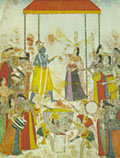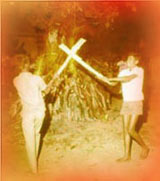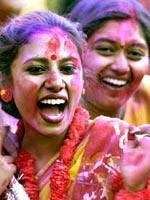
.jpg)


.jpg)

It is celebrated on different days in different parts of Mathura mandala, and ends around the purnima. In Bengal it is celebrated on the purnima.
Hareeyaalee rangon se bharee hooee pichkaaree penko
-Throw pichkaarees filled with vibrant colours
nidhi se bhare hooe matkon ko toro
-break treasure-filled mutkaas (pinaataas)
rang se khelo aur karo vair ko paar
-play with coloured powder and dispense with hate
kyonkee ayee holi ka tyohaar
-for it is Holi today.
HOLI & DHULETI
( Festival of Colour )
Essentially a spring festival, there are several accounts of how Holi came
to be celebrated. By one account demoness Hoda was killed by children by
inducing her on a heap which was then lighted thereby circumventing her
boon of immortality.
Another version treats it as a day when child Krishna had sucked the demoness
Putana to death. In yet another version which is popular in Gujarat, Prahlad,
the son of the demon king Hiranyakashyap had emerged unhurt from the heap
of fire in which he was made to sit in the lap of Holika, who got burnt
instead. Thus on a full moon day of Phalgun Sud 15 Holi is celebrated to
commemorate the event of one's belief. It is done by lighting the bonfire
of wood and cowdung which is erected in a conical shape over a small pit
whic is dug in the bottom. Such fires are lit on almost all important cross-sections
of road or in the chawk of the villages. Elders predict about the coming
monsoon on the basis of the direction in which the flag planted atop falls.
Devotees offer coconut into the fire and the youth retrieves them from
the fire amidst applause of bystanders. It is also the principal religious
festival of Adivasis in Gujarat. They abandon work and indulge in ceaseless
folk dancing. Their girls observe this festival by growing wheat in the
bamboo baskets filled with earth and manure. In some tribes the people
indulge in foulest of abuse and mock fights.
The day next to Holi is Dhuleti or Dhuli Padvo. Literally it means throwing of mud, the practice which has given way to throwing of vermilion. At times the merrymaking lapses into unhindered revelry as youngsters indulge into throwing paste colours, not only on their friends but also on the strangers taking advantage of the permissiveness granted on the occasion. As noted earlier Adivasis truely celebrate this festival. In the villages of Panchmahals, Adivasi men and women play a martial game known as Gol-Gadheda in which the women after snatching shoulder scarf from a man, ties it on a treetop with a lump of molasses. It is the job of a man to retrieve it from there, not an easy task as women vigorously guards the tree. The game goes on till one of the men succeeds in securing the bundle. Such is the boundless merrymaking of the day.
Amongst India's innumerable festivals, Holi ranks as the most colourful. It celebrates the arrival of spring and death of demoness Holika, it is a celebration of joy and hope. Holi provides a refreshing respite from the mundane norms as people from all walks of life enjoy themselves. In a tight knit community, it also provided a good excuse for letting off some steam and settling old scores, without causing physical injury.
Holi continues to be celebrated with great vigour through out India. Countless Hindi films have brought the vibrant colours of the festival to the screen. Indians all over the world eagerly await the Festival of Colours, as bonfires are lit to banish the cold dark nights of winter and usher in warmer spring. Dhuleti, day after Holi, is the actual festival of colours, when everything in sight is covered in a riot of colours.
Twin towns of Nandagow (Nanadagram) ( where Lord Krishna grew up ) and Barsana (Varshana) (where Shri Radha grew up), near Mathura, are the epicentre of the celebrations. Lord Krishna, while growing up in Vraj, popularised the festival with his ingenious pranks. Gopies of Vraj responded with equal enthusiasm and the festivities have continued ever since. Role reversal, feminism etc. are accepted customs for the duration of the festival! Men and women of Vraj clash in a colourful display of battle of the sexes.
Celebrations start a week earlier than rest of India. Men of Nandagow raid Barsana with hopes of raising their flag over Shri Radhikaji's temple. They receive a thunderous welcome as the women of Barsana greet them with long wooden sticks. The men are soundly beaten as they attempt to rush through town to reach the relative safety of Shri Radhikaji's temple. Men are well padded as they are not allowed to retaliate. In this mock battle the men try their best not to be captured. Unlucky captives can be forcefully lead away, thrashed and dressed in female attire before being made to dance!!
Rush through Barsana is far more lethal than running with the bulls in Spain, at least you don't have to marry them one day! Famous poets like Surdas, Nand-das, Kumbhan-das and others, have written beautifully as to how Lord Krishna was similarly received and forced to wear a sari, forced to wear make-up and made to dance before being released by the gopies of Vraj.
The next day, men of Barsana reciprocate by invading Nandagow. Clouds of pink and white powder mark the frenzy of activity taking place in it's narrow streets. A naturally occurring orange-red dye, Kesudo, is used to drench all participants. Today, the women of Nadagow beat the invaders from Barsana. It is a colourful site. In the interest of tourisum and safety, the state tourist board has set up excellent vantage points for the public. A large open ground, on the outskirts of the town is specially set aside for the most magnificent display of the festivities.
The next day, the temples in Vrindavan celebrate the festival with great guesto. The renowned temple of Bakai-Bihari, the beloved lord of the 15th century saint Haridas, is at the centre of the festivities. Clouds of pink and white descend upon the pilgrims, as the Lord of Vrindavan plays holi with all his beloved visitors.
The festival moves on to other parts of Vraj. Soon enough, it is Dhulati and entire India celebrates the joys of spring as the "festival of colour".
Gulal-Kund in Vraj is a beautiful little lake, set in a delightful groves near the mountain Govardhan, in the Mathura district. Here the festival is commemorated on a more regular basis. Pilgrims who visit the holy land of Vraj, can see the re-enactments of Holi throughout the year at this lake. Local boys, acting in the Krishna-Lila drama troupes re-enact the scenes of holi for the pilgrims.
Royal courts all over North India refined the festival in to an art form of its own. Rajput warriors of the Rajasthani courts used to show off their equestrian skills during the festival. Rajput men would ride their steeds through the white and pink clouds of colour, throwing colour powders on each other. Even the members of the royal families were not immune from being drenched by colour. The entire court would be drenched in saffron water and an orange-red dye of the "kasuda" flowers.
Pushti-Marga temples, spread throughout North and Western States of India, celebrate the festival in a way reminiscent of rajput courts. The Deity, and the laity, are liberally sprinkled with perfumes, saffron water, kesudo, and covered in sandalwood as well as the white and pink powder, abil and gulal. Joyous celebration is accompanied by classical music, poetry and folk songs appropriate for the occasion. Deity's white clothes' are soon transformed into a mass of colour as gold and silver syringes spray colourful water on all participants.
The celebrations officially usher in the pleasant season of spring. In the Pushti-Marga temples (of Vallabhacarya), the festivities last for almost a month. Beginning on the day of Vasant-Panchami, the festivals last till the day after Holi. This helps prolong the season of joy.
Poem :- The weather is most pleasant and the spring flowers
are in full bloom. Skies are clear, days are warm and nights are pleasantly
cool. What more could you ask for, except to be covered in the "ranga"
(colour) of your beloved!

Holi will start on March in Varsana, something worth experiencing once
in a lifetime. But be warned, you may spend two hours getting out of the
parking lot.
Although colours are being thrown all day, the real festivities start in the afternoon around 3 pm when the brahmanas from Nandagram come charging into the Varsana Temple carrying the flag of Nandalal. After running all around the temple they sit in the courtyard, which is an ocean of coloured water, facing all the brahmanas from Varsana and sing ancient Holi songs back and forth. People are throwing colours from all the four corners of the singing groups and there is a nice breeze on the hill of Varsana so you will see a red cloud cutting across a yellow cloud. A blue cloud cutting across a pink one. Green one cutting across red one. It all blows in the air and the scene looks like something from the spiritual world. From the balcony they are shooting big brass syringes (pichkaris) of yellow water made from a special dried flower. The singers become completely black and blue from the mixture.
Then around 4:30 pm , the brahmanas from Nandagram go downstairs with big turbans on their heads and carrying brightly coloured rhinoceros-skin shields. There in the street below, Rangili Gulli, the brahmanis of Varsana are waiting for them with big thick long bamboo poles. The Nandagram brahmanas hurl insults at the girls and squat down with the shield over their turbans and four–five brightly dressed girls whack them with all their might with their dandas (sticks). This is the famous Latmar Holi of Varsana.
Then next day, March 20, the same thing happens in Nandagram with all the Varsana brahmanas coming with turbans and shields and Radharani's flag. But somehow there are more Nandagram brahmanis than Varsana brahmanas, so you will see six–seven of these girls letting these guys really have it! And the difference is that is after it is over in Nandagram, you can easily get in your car and drive away. There is not so much rush, but you essentially can experience the same thing that happened the previous day in Varsana.
From the Ekadasi, Holi starts in Vrindavan, so watch out. Wherever you go, you will be pelted with colour and water. Except surprisingly, the main festival is at Banke Bihari that morning up till noon , where they only throw dry colours and it is quite nicely done. There is no targeting of a particular gender or colour, but everyone is throwing colour in the air and shouting, "Banke Bihari Lala Ki Jaya!! I was very surprised how pleasantly it was done. Outside on the streets coming and going, though, there is a bit of hooliganism with targeting of a particular gender and especially colour.
This goes on until sundown every day and after dark it is safe to go to Loi Bazaar for shopping or to different temples for darsana (viewing of the dieities).
This all goes on up till the full moon, with everyone being fair game. This is the heaviest day. And then suddenly at noon on purnima it all stops. There is actually a law that it must stop at noon . And believe it or not, it is practically the only law strictly followed in all of India . By 1 pm it is all over. Everyone comes to 4:30 darsana with brand new white cloth or else the marvellously coloured cloth they wore all week and there is no more colour throwing!
In a few small villages around, they have their own day for Holi even after this also. Like in Gokula, they celebrate on the Pancami. But most places it is all over.
So if you want to join the fun, please be informed. Or if you want to
avoid, you have now been warned.
Deena Bandhu Dasa
HOLI CELEBRATIONS-""aaj brij me holiya re rasiya ""
http://www.youtube.com/watch?v=ZHXyJoihxIs&feature=related
